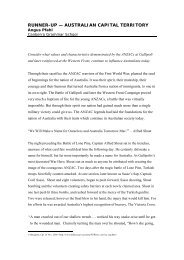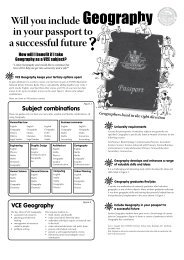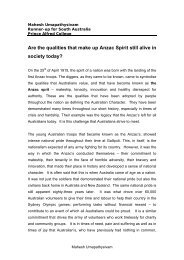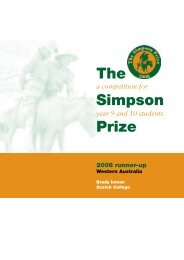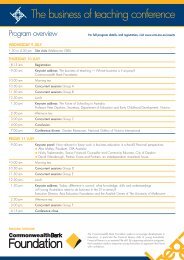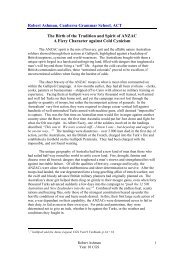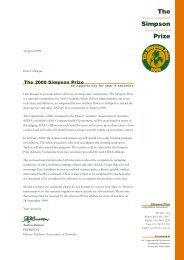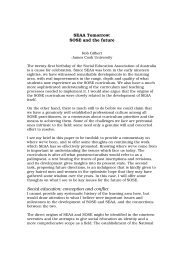Emma Johnson - afssse
Emma Johnson - afssse
Emma Johnson - afssse
You also want an ePaper? Increase the reach of your titles
YUMPU automatically turns print PDFs into web optimized ePapers that Google loves.
WINNER — SOUTH AUSTRALIA<br />
<strong>Emma</strong> <strong>Johnson</strong><br />
Wilderness School<br />
Consider what values and characteristics demonstrated by the ANZACs at Gallipoli and<br />
later reinforced at the Western Front, continue to influence Australians Today.<br />
Despite the calamity and death of the campaigns at Gallipoli and the Western Front, all<br />
was not lost. The Australian and New Zealand soldiers demonstrated many key values<br />
and characteristics that have been remembered and are widely recognised and admired in<br />
society today. In particular, the ANZACs displayed remarkable resilience, mateship and<br />
pride.<br />
Resilience is a highly regarded characteristic that was admired in the ANZAC soldiers at<br />
Gallipoli and later at the Western Front. The soldiers faced many hardships, however the<br />
ANZACs persevered and kept fighting for their country, even though circumstances were<br />
so arduous. Historian CEW Bean (1924) described the great resilience shown by the<br />
Wellington Battalion. ‘Of the 760 … there came out only 70 unwounded or slightly<br />
wounded men. Throughout that day not one had dreamed of leaving his post. Their<br />
uniforms were torn, their knees broken. They had had no water since the morning; they<br />
could talk only in whispers; their eyes were sunken; their knees trembled.’(cited in Dolan<br />
and Meyers, 2005) At the Western Front resilience was also vividly displayed. Archie<br />
Barwick wrote in his diary, ‘All day long ground rocked and swayed backwards and<br />
forwards from the concussion …men were driven stark staring mad …were nearly all in a<br />
state of silliness and half dazed but still the Australians refused to give ground.’ (cited in<br />
MacFarlane, I, date unknown) This type of endurance is very special. For someone to<br />
keep going when everything around them is diminishing is truly amazing. Today<br />
resilience is most recognised in the Australian farmers. The farmers have been the hardest<br />
hit in a seemingly inexhaustible drought that has lasted over six years. Farmers are forced<br />
to live in dustbowl conditions, raising emaciated livestock and in huge debt. Many<br />
farmers have given up their land; however, many still remain, determined to push through<br />
these difficult times. NSW Liberal senator Bill Heffernan (2006), who runs a farm<br />
himself, said ‘Australia's farmers were resilient in the face of hardship.’ (cited in The<br />
Age, 2006) Another source (2006) stated that ‘Australia's farmers are typically tough,<br />
resilient and resourceful – qualities that have enabled generations of country families to
tough it out in hard times of drought and bushfires.’ (cited in Stuff) The majority of men<br />
and women that endure these harsh circumstances continue to push through the pain and<br />
are resilient in all ways determined to keep Australia’s agricultural industry together.<br />
Resilience is recognised in many generations of Australian citizens since Gallipoli and<br />
the Western Front. We are known as the Aussie bush battlers.<br />
Mateship is one of the most significant values in Australian society. Mateship is in fact<br />
one of Prime Minister John Howard’s favourite terms. He even attempted to have it<br />
included in the preamble to the constitution at the 1999 referendum. Although the<br />
referendum passed, John Howard often uses the term when defining the nation. The<br />
definitive molding of mateship is thought to have originated during World War One and<br />
ever since the impeccable demonstration of mateship at Gallipoli and at the Western<br />
Front this priceless quality has been admired by all Australians. Historian CEW Bean<br />
(1924), recounted at Gallipoli how two soldiers willingly helped each other out, ‘He<br />
(Colonel Clarke) was carrying his heavy pack, and could scarcely go further. Laing<br />
advised him to throw the pack away, but Clarke was unwilling to lose it, and Laing<br />
thereupon carried it himself.’ (cited in Board of Studies, 2001) At the Western Front<br />
mateship like this was also seen when Australian soldiers disobeyed the British order to<br />
not rescue wounded men in the open in case they themselves were wounded. ‘They could<br />
not leave their mates stranded and calling for help. One officer walked across the<br />
battlefield and made a truce with the Germans. He even offered himself as a prisoner<br />
while his men tried to find all the Australian wounded.’ (Anzac Day Commemoration<br />
Committee (QLD) Incorporated, 1998) Mateship like this has been remembered and<br />
celebrated and has a strong influence on Australians today. Remarkable mateship was<br />
displayed when earlier this year two miners were trapped inside a mine in Beaconsfield,<br />
Tasmania for fourteen days. Prime Minister John Howard (2006) commended this<br />
mateship when he stated ‘Everybody was working together, differences of occupation and<br />
background, religious and political belief was put aside. A whole community was united<br />
in its determination to achieve a result.’ (cited in The Prime Minister of Australia) The<br />
bonds of mateship that the ANZACs showed are reflected in the saying for which<br />
Australia is most renowned, ‘G’day mate!’
Pride is an important characteristic displayed at Gallipoli, the Western Front and to this<br />
present day. The ANZACs showed great pride in themselves after overcoming obstacles<br />
and pride in their mates as they successfully accomplished a day’s work of fighting and<br />
pride in their country. After fighting at Gallipoli, soldier Roy Denning (1915) wrote to his<br />
mother ‘I was justified in being proud of being an Australian.’(cited in The Anzac<br />
Landing) At the Western Front pride was demonstrated when ‘His (Major Black) men<br />
leapt through with him, and fought their way into the German trenches. They were the<br />
first soldiers to break through the Hindenburg line. Proudly they looked for Major Black.<br />
But he lay dead on the wire.’ (Anzac Day Commemoration Committee (QLD)<br />
Incorporated, 1998) This pride is still evident in today’s society. Our citizens are proud to<br />
live in a country that is safe, where we have the freedom of speech and where everyone is<br />
accepted. Australia is the envy of many people and Australians are proud to live here. In<br />
2000 when Cathy Freeman lit the Olympic Cauldron she held the uttermost pride within<br />
her as she received the flame and ascended the stairs towards the cauldron. In an<br />
interview after receiving news that she had been selected to light the cauldron Freeman<br />
stated ‘I’m very, very honored. I'm very proud.’(CNN Sports Illustrated, 2001) Having<br />
Cathy Freeman light the Olympic cauldron was especially significant due to her<br />
Aboriginal descent. Often after winning a race Freeman carried the Australian flag along<br />
with the Aboriginal flag in order to manifest her pride in the heritage of her people.<br />
Freeman stated ‘I just wanted to show I am proud of who I am and where I come<br />
from.’(Hudson, 2005) Pride was a key element shown at Gallipoli and the Western Front<br />
and is widely demonstrated in today’s society as Australia’s citizens are proud to live in<br />
Australia.<br />
The ANZACs were truly inspiring soldiers, holding their heads high in times of tragic<br />
loss. At Gallipoli and the Western Front, soldiers were mentally, physically and<br />
emotionally challenged. However, with the support of their mates and the desire to make<br />
their country proud, the soldiers continued to run, continued to fight and continued to<br />
survive. This transfixed the minds of many Australians and these qualities are, to this<br />
present day appreciated, admired and demonstrated. Mateship, pride and resilience are<br />
shown by the Australian farmers, the Beaconsfield miners and Cathy Freeman portraying<br />
to the whole world the treasured spirit and qualities of Australians that have lived on ever<br />
since Gallipoli and the Western Front.
Word Count: 1 180<br />
Bibliography<br />
Anzac Day Commemoration Committee (QLD) Incorporated, 1998, ‘The Western Front’<br />
in Anzac Day, <br />
[Accessed 21/09/2006]<br />
‘Australian farmers commit suicide as hope evaporates’, 2006, in Stuff,<br />
[Accessed 28/10/2006]<br />
Board of Studies NSW, 2001 ‘Gallipoli and the Australian Homefront.’ The Anzac<br />
Landing, [Accessed<br />
24/09/2006]<br />
Board of Studies NSW, 2001‘North Beach and the Sari Bair Rang.’ The Anzac Landing,<br />
[Accessed 19/09/2006]<br />
CNN Sports Illustrated, 2001, ‘Australian Track star Cathy Freeman’<br />
[Accessed 24/10/2006]<br />
Dolan, B and Meyers T, 2005. ‘Anzac officers that Died at Gallipoli’,<br />
[Accessed 29/10/2006]<br />
‘Forcing farmers off the land un-Australian’ in The Age<br />
<br />
[Accessed 28/10/2006]<br />
Howard, J. 2006, ‘Speeches’ in the Prime Minister of Australia,<br />
[Accessed 23/09/2006]<br />
Hudson, C. 2005, ‘Sports Hero: Cathy Freeman’ in Sports Heroes,<br />
[Accessed<br />
24/10/2006]<br />
MacFarlane, I. Date unknown, ‘Defending Victoria’<br />
[Accessed 28/10/2006]




